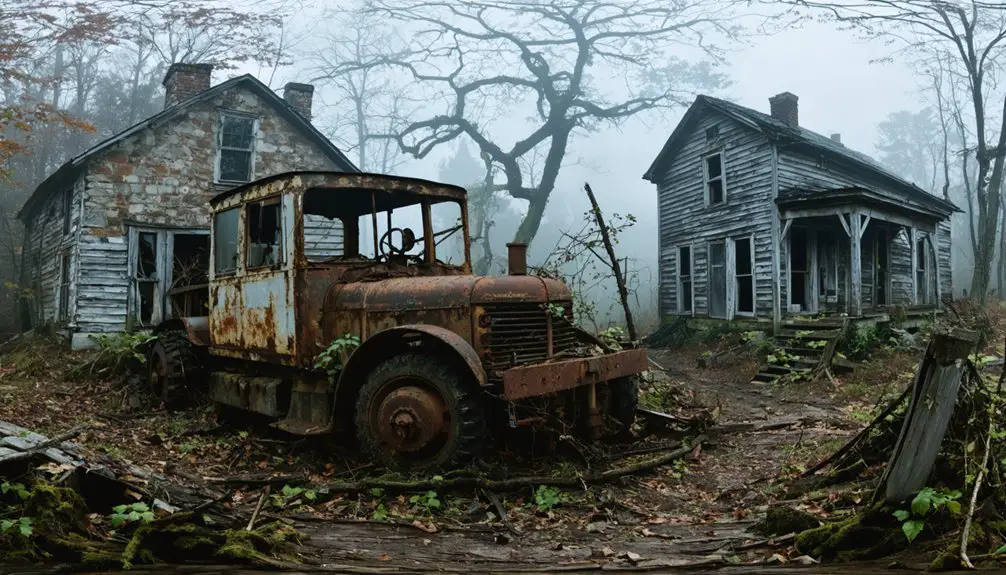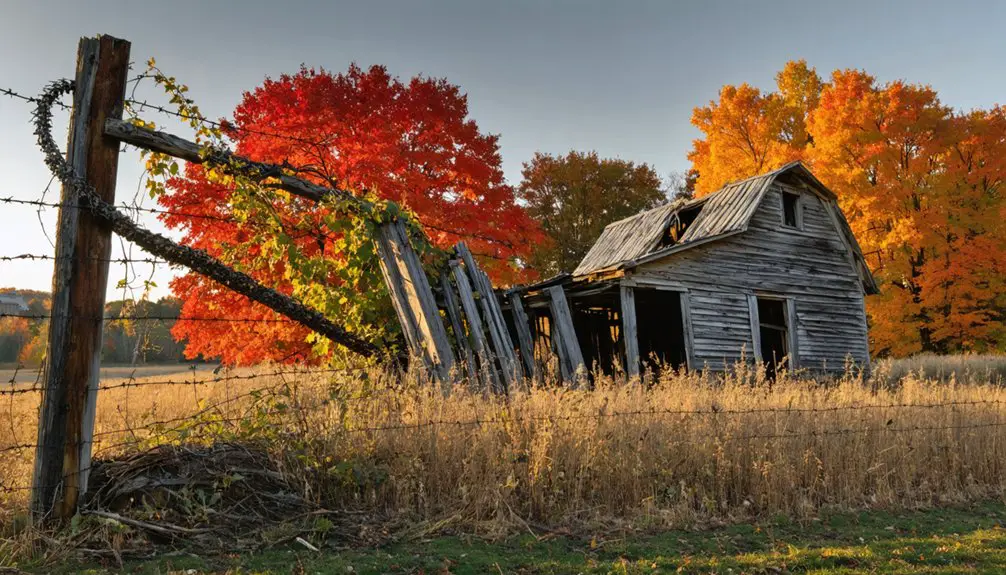You’ll find North Walden’s ghostly remains tucked away in Vermont’s rugged landscape, where a once-thriving mill town met its demise through devastating fires and resource depletion. The community flourished in the 1800s with water-powered mills, hotels, and sheep farming, but a series of mill fires between 1946-2003 accelerated its decline. The area’s dark reputation includes unexplained disappearances that led to the creation of the Vermont State Police, while archaeological evidence hints at deeper mysteries beneath the ruins.
Key Takeaways
- North Walden transformed from a thriving mill town into a ghost town due to devastating fires and industrial decline throughout the 1900s.
- The town’s economy collapsed after natural resources, particularly timber, became depleted through intensive logging and resource extraction.
- Multiple mill fires between 1946 and 2003 destroyed vital infrastructure, forcing businesses to close and workers to seek employment elsewhere.
- Archaeological evidence includes ruins of canal systems, charcoal kilns, and brick fragments that reveal the town’s industrial past.
- The area gained notoriety for unexplained disappearances and folklore, leading to its inclusion in the “Bennington Triangle” region.
The Rise and Fall of a Mountain Community
While the dense forests and mountainous terrain of Vermont’s Green Mountains initially attracted settlers to North Walden in the early 19th century, the community’s story embodies both the promise and perils of frontier settlement.
You’ll find evidence of community resilience in the town’s early development, with settlers establishing water-powered mills, a hotel, and town hall by the 1830s. The rugged landscape demanded environmental adaptation as inhabitants faced harsh New England winters and remote isolation. Much like the ghost town of Glastonbury, the area faced significant challenges in maintaining its population. The area thrived particularly due to sheep farming operations, with nearly fifteen thousand sheep populating the Danville region by the 1870s.
Despite their resourcefulness, the settlement’s fortunes declined when forest resources dwindled and a devastating fire destroyed the essential woolen mill. The destruction spread to critical infrastructure, including a bridge and post office, while social tensions and violent incidents like the Patch Hollow dispute further weakened the community’s foundation.
Economic Hardships and Industrial Collapse
You’ll find North Walden’s early industrial vigor drastically impacted by devastating mill fires, which destroyed critical production facilities and eliminated key employment opportunities.
Similar to Middlebury’s industrial wage workers, local laborers sought employment at regional factories as traditional farming declined.
The area’s economic stability further eroded as readily accessible natural resources, particularly timber stands near transportation routes, became depleted through intensive harvesting.
These compounded hardships, alongside the broader technological shifts of the era, left North Walden struggling to maintain its industrial base, ultimately accelerating its transformation into a ghost town.
Like Vermont’s Jones and Lamson Factory, the town experienced a devastating multi-decade decline that permanently altered its economic landscape.
Mill Fire Impact
Throughout the mid-to-late 20th century, North Walden’s mill complex endured a devastating series of fires that ultimately led to its industrial collapse and permanent closure in 2003.
You can trace the mill’s decline through major fires in 1946, 1973, 1977, and 1978, with each incident weakening both fire safety measures and community resilience. The 1978 blaze destroyed the planing mill, forcing operations to relocate to a secondary site at route 10/302. Similar to Brattleboro’s repeated rebuilding efforts, local workers struggled to maintain operations after each destructive fire.
The mill’s struggles mirrored broader trends, as smaller mills disappeared while larger, specialized operations continued to thrive in the region.
Despite maintaining production of up to 500,000 board feet of pine lumber weekly, repeated fires disrupted the mill’s output and reliability.
These setbacks, combined with rising foreign competition and unstable lumber markets, made recovery increasingly difficult. The mill’s eventual transformation into retail space marked the end of North Walden’s industrial era.
Resource Depletion Effects
As North Walden’s natural resources steadily vanished in the early 1900s, the town’s industrial foundation began to crumble. A lack of resource management and sustainable practices led to devastating consequences.
You’d have witnessed forests disappearing at an alarming rate, stripped bare by intensive logging and wood-hungry locomotives. The town’s charcoal kilns, once essential for iron production, fell silent as timber supplies dwindled.
The exhaustion of natural resources created a devastating chain reaction. The land’s decline mirrored how ancient mountain range remnants had eroded away millions of years before. You would’ve seen sand and gravel deposits diminish, while groundwater quality suffered.
Local businesses, from sawmills to ironworks, couldn’t survive without raw materials. As these industries collapsed, workers left town, searching for opportunities elsewhere. The town’s economy, built on resource extraction, couldn’t adapt quickly enough to prevent its decline.
Tales of Mystery and Disappearances
Dark mysteries and unexplained disappearances have plagued North Walden and its surrounding wilderness since the mid-1940s.
You’ll find documented cases like Middie Rivers, a 75-year-old guide who vanished while leading hunters, and Paula Welden, a college student who disappeared during a winter hike. These mysterious disappearances led directly to the creation of the Vermont State Police.
Haunting disappearances in Vermont’s wilderness forced a response – the birth of a state police force born from mystery.
Author Joseph Citro dubbed this 36-mile wilderness area The Bennington Triangle in 1992.
The area’s folklore deepens its enigmatic character. The dark history includes a violent mob that once attacked a man by prying a hole through his roof.
You’re likely to hear tales of ghostly sightings, strange lights, and monstrous creatures in the dense forests. Local legends trace back to indigenous stories and early colonists’ accounts.
The rugged terrain and unpredictable weather of Glastenbury Mountain create perfect conditions for people to vanish without a trace, while historical violence, like the Patch Hollow Massacre, adds another layer of darkness to the region’s haunting reputation.
Uncovering the Archaeological Remains
You’ll find the most prominent archaeological feature at North Walden in the ruins of the Vermont Valley Woolen Mill, where stone foundations and charred remnants reveal the catastrophic fire that marked the town’s decline.
The mill’s structural footprint shows evidence of typical New England industrial architecture from the late 1800s, with surviving stonework indicating the building’s original scale and layout. Similar to the economy of Ricker Basin, three local sawmills once drove industrial activity before floods led to abandonment.
Archaeological analysis of the ruins has uncovered machinery fragments, tools, and building materials that help reconstruct the mill’s operational history and its central role in the community’s economy.
Mill Ruins Today
While nature has steadily reclaimed the North Walden mill site over decades, the ruins still offer archaeologists and historians valuable insights into Vermont’s industrial past.
You’ll find remnants of the mill architecture scattered near former mill ponds and waterways, where stone foundations once supported waterwheels and bellows houses. The historical significance of these ruins extends beyond the main structures – you can spot traces of canal systems, charcoal kilns, and auxiliary buildings that supported the complex industrial operation.
Despite vegetation obscuring many features, the site maintains moderate to high archaeological sensitivity. Brick fragments, slag deposits, and structural stones persist, though organic materials have largely disappeared.
At remote sections of the ruins, you’ll discover better-preserved artifacts where human interference has been minimal.
Structural Evidence Analysis
Archaeological investigations at North Walden have revealed extensive structural evidence through systematic excavation and analysis.
Through careful post moulds analysis, you’ll find the exact footprints of former wooden buildings, while scattered artifacts tell the story of daily life within these structures.
You can trace the town’s layout through soil discolorations that mark where posts once stood, with nearby hearths indicating cooking and heating areas.
Artifact distribution patterns show where specific activities took place – hammerstones and whetstones suggest tool maintenance zones, while bone awls and needles point to textile work areas.
Fire-cracked rock concentrations mark the locations of former fireplaces, and middens filled with pottery fragments and tool flakes reveal how residents used their living spaces.
This evidence paints a clear picture of North Walden’s structural organization and daily activities.
Legends and Local Folklore

Deep within Vermont’s rugged terrain, North Walden’s folklore stems from centuries of mysterious occurrences and spiritual beliefs.
You’ll find tales of ancient spiritual rituals where Indigenous priests conducted ceremonies among echo-filled ravines, including sacrifices to Hobomocko at the blood-stained Devils’ Altar. The area’s haunting reputation intensified with unexplained disappearances, like Paula Welden in 1946 and hunter Middie Rivers, both vanishing in the dense Bennington Triangle woods.
Ghost stories permeate abandoned structures, particularly the North Walden creamery, where a janitor’s tragic tale spawns reports of phantom chills and disembodied sounds.
Local treasure hunters still whisper about Uncle Sim’s failed quest for silver, while Lucky Seven Cave draws modern spiritual practitioners to its mysterious confines.
Natural Disasters That Shaped Destiny
Throughout North Walden’s brief existence, a perfect storm of natural calamities hastened its transformation into a ghost town. The community’s resilience was tested by environmental challenges that proved insurmountable, ultimately forcing residents to abandon their mountain homes.
Nature’s endless siege on North Walden proved too much, forcing mountain residents to surrender their homes to the wilderness.
The settlement faced devastating natural forces:
- Extreme mountain weather brought dangerous winds and sudden storms, isolating residents during harsh winters and disrupting crucial travel routes.
- Widespread deforestation from logging led to erosion, wildlife habitat loss, and increased wildfire risks from charcoal production.
- Unstable terrain caused landslides and rockslips that threatened buildings and blocked access roads.
- The combination of severe weather and stripped landscapes accelerated soil degradation, making farming increasingly difficult.
These relentless natural pressures, compounded by human activities, sealed North Walden’s fate.
Legacy in Vermont’s Rural History
North Walden’s transformation into a ghost town mirrors a broader pattern in Vermont’s rural development, where resource-dependent settlements rose and fell with the changing economic tides of the 19th century.
You’ll find its story interwoven with the cultural heritage of communities like Greenbank’s Hollow, where woolen mills once drove local economies until disaster struck.
The town’s legacy extends beyond its physical remains, capturing the essence of Vermont’s rural evolution.
Through historical preservation efforts, you can trace the economic shifts from timber harvesting to industrial decline that shaped these mountain communities.
Like many of its contemporaries, North Walden stands as a reflection of the cyclical nature of resource-based economies and the profound impact of industrialization on Vermont’s rural landscape.
Frequently Asked Questions
Are There Any Surviving Maps Showing North Walden’s Original Town Layout?
You’ll find North Walden’s layout on Beers’ 1875 map and early lot plans, though historic preservation efforts haven’t yielded standalone town planning documents – it’s mostly shown within broader Walden maps.
What Happened to the Town’s Cemetery and Burial Records?
You’ll find North Walden Cemetery’s 319 memorials still preserved and accessible, with burial records maintained through town clerk offices, genealogical collections, and Find A Grave’s digital archives since the 1700s.
Did Any Families Maintain Property Ownership After the Town’s Abandonment?
You’ll find some descendants held onto their ancestral lands through property inheritance, maintaining family legacies despite the town’s emptiness. They’ve kept deeds active, though most lots remain undeveloped and rarely visited.
Where Did Most of North Walden’s Residents Relocate To?
Following residential migration patterns, you’ll find most displaced residents moved to Danville and St. Johnsbury, Vermont, where established infrastructure and economic opportunities helped absorb the community displacement from their former town.
Are There Any Photographs of North Walden Before Its Decline?
Like uncovering hidden treasures, you’ll find Richard Brown’s photographs from 1971 onward capture the region’s historical significance, while Vermont Historical Society archives preserve architectural features through various collections, though specific North Walden images are rare.
References
- https://www.youtube.com/watch?v=YrQNbrIrNT8
- https://www.youtube.com/watch?v=6zrC4j7tGHE
- https://vermontcountry.com/2023/10/26/the-haunting-of-glastenbury-mountain/
- https://urbanpostmortem.wordpress.com/2012/12/18/the-patch-hollow-massacre/
- https://ournewenglandlegends.com/the-mystery-of-glastenbury-mountain-vermont/
- https://obscurevermont.com/the-patch-hollow-massacre/
- https://en.wikipedia.org/wiki/List_of_ghost_towns_in_Vermont
- https://www.moover.com/wp-content/uploads/2021/06/HistoryofMillStreet.pdf
- https://sites.middlebury.edu/walkingmiddlebury/mill-street-and-park-street/
- https://obscurevermont.com/the-jones-and-lamson-factory/



